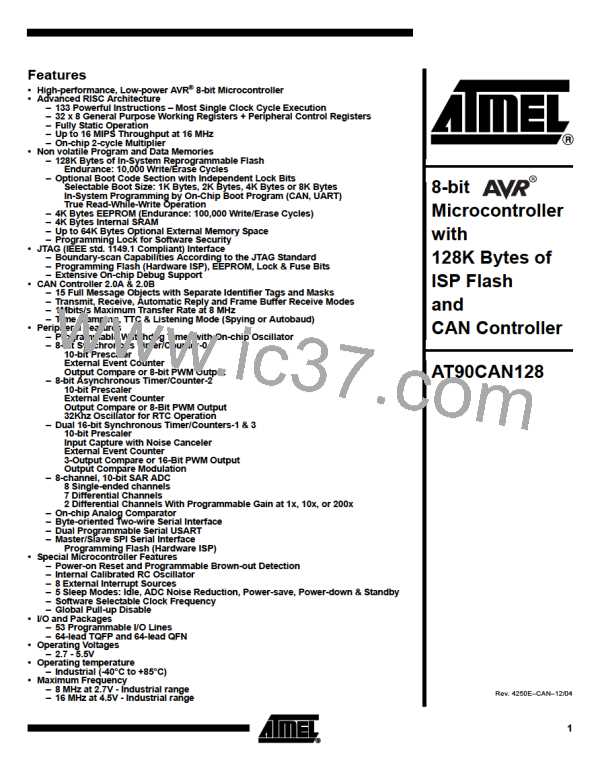The counter will then have to count to the MAX value (0xFFFF) and wrap around start-
ing at 0x0000 before the compare match can occur. The OCRnA Register however, is
double buffered. This feature allows the OCRnA I/O location to be written anytime.
When the OCRnA I/O location is written the value written will be put into the OCRnA
Buffer Register. The OCRnA Compare Register will then be updated with the value in
the Buffer Register at the next timer clock cycle the TCNTn matches TOP. The update is
done at the same timer clock cycle as the TCNTn is cleared and the TOVn flag is set.
Using the ICRn Register for defining TOP works well when using fixed TOP values. By
using ICRn, the OCRnA Register is free to be used for generating a PWM output on
OCnA. However, if the base PWM frequency is actively changed (by changing the TOP
value), using the OCRnA as TOP is clearly a better choice due to its double buffer
feature.
In fast PWM mode, the compare units allow generation of PWM waveforms on the
OCnx pins. Setting the COMnx1:0 bits to two will produce a non-inverted PWM and an
inverted PWM output can be generated by setting the COMnx1:0 to three (see Table on
page 132). The actual OCnx value will only be visible on the port pin if the data direction
for the port pin is set as output (DDR_OCnx). The PWM waveform is generated by set-
ting (or clearing) the OCnx Register at the compare match between OCRnx and TCNTn,
and clearing (or setting) the OCnx Register at the timer clock cycle the counter is
cleared (changes from TOP to BOTTOM).
The PWM frequency for the output can be calculated by the following equation:
fclk_I/O
fOCnxPWM = ----------------------------------
N ⋅ (1 + TOP)
The N variable represents the prescaler divider (1, 8, 64, 256, or 1024).
The extreme values for the OCRnx Register represents special cases when generating
a PWM waveform output in the fast PWM mode. If the OCRnx is set equal to BOTTOM
(0x0000) the output will be a narrow spike for each TOP+1 timer clock cycle. Setting the
OCRnx equal to TOP will result in a constant high or low output (depending on the polar-
ity of the output set by the COMnx1:0 bits.)
A frequency (with 50% duty cycle) waveform output in fast PWM mode can be achieved
by setting OCnA to toggle its logical level on each compare match (COMnA1:0 = 1). The
waveform generated will have a maximum frequency of fOC A = fclk_I/O/2 when OCRnA is
n
set to zero (0x0000). This feature is similar to the OCnA toggle in CTC mode, except the
double buffer feature of the Output Compare unit is enabled in the fast PWM mode.
Phase Correct PWM Mode
The phase correct Pulse Width Modulation or phase correct PWM mode (WGMn3:0 = 1,
2, 3, 10, or 11) provides a high resolution phase correct PWM waveform generation
option. The phase correct PWM mode is, like the phase and frequency correct PWM
mode, based on a dual-slope operation. The counter counts repeatedly from BOTTOM
(0x0000) to TOP and then from TOP to BOTTOM. In non-inverting Compare Output
mode, the Output Compare (OCnx) is cleared on the compare match between TCNTn
and OCRnx while upcounting, and set on the compare match while downcounting. In
inverting Output Compare mode, the operation is inverted. The dual-slope operation has
lower maximum operation frequency than single slope operation. However, due to the
symmetric feature of the dual-slope PWM modes, these modes are preferred for motor
control applications.
The PWM resolution for the phase correct PWM mode can be fixed to 8-, 9-, or 10-bit, or
defined by either ICRn or OCRnA. The minimum resolution allowed is 2-bit (ICRn or
124
AT90CAN128
4250E–CAN–12/04

 ATMEL [ ATMEL ]
ATMEL [ ATMEL ]